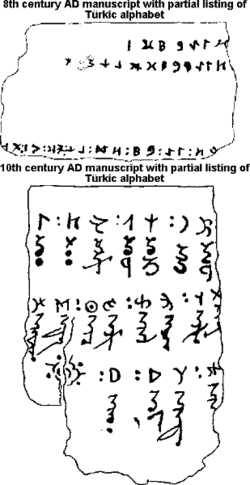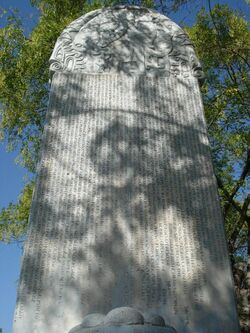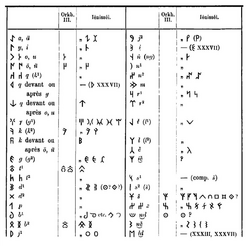Social:Old Turkic alphabet
The Old Turkic script (also known as variously Göktürk script, Orkhon script, Orkhon-Yenisey script) is the alphabet used by the Göktürks and other early Turkic khanates during the 8th to 10th centuries to record the Old Turkic language.[1]
The script is named after the Orkhon Valley in Mongolia where early 8th-century inscriptions were discovered in an 1889 expedition by Nikolai Yadrintsev.[2] These Orkhon inscriptions were published by Vasily Radlov and deciphered by the Denmark philologist Vilhelm Thomsen in 1893.
This writing system was later used within the Uyghur Khaganate. Additionally, a Yenisei variant is known from 9th-century Yenisei Kirghiz inscriptions, and it has likely cousins in the Talas Valley of Turkestan and the Old Hungarian alphabet of the 10th century. Words were usually written from right to left.
Origins
According to some sources, Orkhon script is derived from variants of the Aramaic alphabet,[3][4][5] in particular via the Pahlavi and Sogdian alphabets,[6][7] as suggested by Vilhelm Thomsen, or possibly via Kharosthi (cf. the inscription at Issyk kurgan).
Another explanation of the script's origin aside from derivation from tamgas, an alternate possible derivation from Chinese characters was suggested by Vilhelm Thomsen in 1893. Turkic inscriptions dating from earlier than the Orkhon inscriptions used about 150 symbols, which may suggest that tamgas first imitated Chinese script and then gradually was refined into an alphabet.
Thomsen (1893) connected the script to the reports of Chinese account (Records of the Grand Historian, vol. 110) from a 2nd century BCE Yan renegade and dignitary named Zhonghang Yue (Chinese: 中行说; pinyin: Zhōngháng Yuè), who "taught the Chanyu (rulers of the Xiongnu) to write official letters to the Chinese court on a wooden tablet (simplified Chinese: 牍; traditional Chinese: 牘; pinyin: dú) 31 cm long, and to use a seal and large-sized folder". The same sources tell that when the Xiongnu noted down something or transmitted a message, they made cuts on a piece of wood (gemu); they also mention a "Hu script". At the Noin-Ula burial site and other Hun burial sites in Mongolia and regions north of Lake Baikal, the artifacts displayed over twenty carved characters. Most of these characters are either identical with or very similar to the letters of the Turkic Orkhon script.[8]
Contemporary Chinese sources conflict as to whether the Turks had a written language by the 6th century. The Book of Zhou, dating to the 7th century, mentions that the Turks had a written language similar to that of the Sogdians. Two other sources, the Book of Sui and the History of the Northern Dynasties claim that the Turks did not have a written language.[9]
Corpus
The Old Turkic corpus consists of about two hundred[10] inscriptions, plus a number of manuscripts.
The inscriptions, dating from the 7th to 10th century, were discovered in present-day Mongolia (the area of the Second Turkic Khaganate and the Uyghur Khaganate that succeeded it), in the upper Yenisey basin in central South Siberia, and, in smaller numbers, in the Altay mountains and in Xinjiang. The texts are mostly epitaphs (official or private), but there are also graffiti and a handful of short inscriptions found on archaeological artifacts, including a number of bronze mirrors.[10] The website of the Language Committee of Ministry of Culture and Information of the Republic of Kazakhstan lists 54 inscriptions from the Orkhon area, 106 from the Yenisei area, 15 from the Talas area, and 78 from the Altai area. The most famous of the inscriptions are the two monuments (obelisks) which were erected in the Orkhon Valley between 732 and 735 in honor of the Göktürk prince Kül Tigin and his brother the emperor Bilge Kağan. The Tonyukuk inscription, a monument situated somewhat farther east, is slightly earlier, dating to ca. 722. These inscriptions relate in epic language the legendary origins of the Turks, the golden age of their history, their subjugation by the China , and their liberation by Bilge.[citation needed]
The Old Turkic manuscripts, of which there are none earlier than the 9th century, were found in present-day Xinjiang and represent Old Uyghur, a different Turkic dialect than the one represented in the Old Turkic inscriptions in the Orkhon valley and elsewhere.[10] They include Irk Bitig, a 9th-century manuscript book on divination.
Table of characters
Old Turkic being a synharmonic language, a number of consonant signs are divided into two "synharmonic sets", one for front vowels and the other for back vowels. Such vowels can be taken as intrinsic to the consonant sign, giving the Old Turkic alphabet an aspect of an abugida script. In these cases, it is customary to use superscript numerals ¹ and ² to mark consonant signs used with back and front vowels, respectively. This convention was introduced by Thomsen (1893), and followed by Gabain (1941), Malov (1951) and Tekin (1968).
Vowels
| Orkhon | Yenisei variants |
Trans- literation |
IPA | |
|---|---|---|---|---|
| Image | Text | |||
| Template:Script/Orkhon | Template:Script/Orkhon | a, e | /ɑ/, /e/ | |
| Template:Script/Orkhon | ı, i | /ɯ/, /i/ | ||
| Template:Script/Orkhon | o, u | /o/, /u/ | ||
| Template:Script/Orkhon | Template:Script/Orkhon | ö, ü | /ø/, /y/ | |
Consonants
- Synharmonic sets
- Other consonantal signs
| Orkhon | Yenisei variants |
Trans- literation |
IPA | |
|---|---|---|---|---|
| Image | Text | |||
| Template:Script/Orkhon | Template:Script/Orkhon | č | /tʃ/ | |
| Template:Script/Orkhon | m | /m/ | ||
| Template:Script/Orkhon | p | /p/ | ||
| Template:Script/Orkhon | Template:Script/Orkhon[11] | š | /ʃ/ | |
| Template:Script/Orkhon | Template:Script/Orkhon | z | /z/ | |
| Template:Script/Orkhon | Template:Script/Orkhon | ṅ | /ŋ/ | |
| Template:Script/Orkhon | ič, či, č | /itʃ/, /tʃi/, /tʃ/ | ||
| Template:Script/Orkhon | Template:Script/Orkhon | yq, qy, q | /ɯq/, /qɯ/, /q/ | |
| Template:Script/Orkhon | Template:Script/Orkhon | -nč | /ntʃ/ | |
| Template:Script/Orkhon | Template:Script/Orkhon | -ɲ | /ɲ/ | |
| Template:Script/Orkhon | -lt | /lt/, /ld/ | ||
| Template:Script/Orkhon | Template:Script/Orkhon | -nt | /nt/, /nd/ | |
| Template:Script/Orkhon | ot, ut[12] | ? | ||
| Template:Script/Orkhon | baš[13] | ? | ||
A colon-like symbol (⁚) is sometimes used as a word separator.[14] In some cases a ring (⸰) is used instead.[14]
A reading example (right to left):
𐱅𐰭𐰼𐰃 ( ![]() )
transliterated t²ṅr²i, this spells the name of the Turkic sky god, Tengri (/teŋri/).
)
transliterated t²ṅr²i, this spells the name of the Turkic sky god, Tengri (/teŋri/).
Variants
This section's factual accuracy is disputed. (November 2008) (Learn how and when to remove this template message) |

Variants of the script were found from Mongolia and Xinjiang in the east to the Balkans in the west. The preserved inscriptions were dated to between the 8th and 10th centuries.
These alphabets are divided into four groups by Kyzlasov (1994)[16]
- Asiatic group (includes Orkhon proper)
- Eurasiatic group
- Southern Europe group
The Asiatic group is further divided into three related alphabets:
- Orkhon alphabet, Göktürks, 8th to 10th centuries
- Yenisei alphabet,
The Eurasiatic group is further divided into five related alphabets:
- Achiktash, used in Sogdia 8th to 10th centuries.
- South-Yenisei, used by the Göktürks 8th to 10th centuries.
- Two especially similar alphabets: the Don alphabet, used by the Khazars, 8th to 10th centuries; and the Kuban alphabet, used by the Bulgars, 8th to 13th centuries. Inscriptions in both alphabets are found in the Pontic–Caspian steppe and on the banks of the Kama river.
- Tisza, used by the Pechenegs 8th to 10th centuries.
A number of alphabets are incompletely collected due to the limitations of the extant inscriptions. Evidence in the study of the Turkic scripts includes Turkic-Chinese bilingual inscriptions, contemporaneous Turkic inscriptions in the Greek alphabet, literal translations into Slavic languages, and paper fragments with Turkic cursive writing from religion, Manichaeism, Buddhist, and legal subjects of the 8th to 10th centuries found in Xinjiang.
Unicode
The Unicode block for Old Turkic is U+10C00–U+10C4F. It was added to the Unicode standard in October 2009, with the release of version 5.2. It includes separate "Orkhon" and "Yenisei" variants of individual characters.
Since Windows 8 Unicode Old Turkic writing support was added in the Segoe font.
See also
- Neolithic signs in China § Banpo and Jiangzhai
- Göktürks
- Irk Bitig – a 9th-century manuscript book on divination in the Old Turkic alphabet
- Khazar language
- Old Hungarian alphabet
- Orkhon inscriptions
- Tariat inscriptions
- Sükhbaatar inscriptions
Notes
- ↑ Scharlipp, Wolfgang (2000). An Introduction to the Old Turkish Runic Inscriptions. Verlag auf dem Ruffel, Engelschoff. ISBN:978-3-933847-00-3.
- ↑ Sinor, Denis (2002). "Old Turkic". History of Civilizations of Central Asia. 4. Paris: UNESCO. pp. 331–333.
- ↑ Cooper, J.S. (2004). "Babylonian beginnings: The origin of the cuneiform writing system in comparative perspective". in Houston, Stephen. The First Writing: Script Invention as History and Process. Cambridge University Press. pp. 58–59.
- ↑ Mabry, Tristan James (2015). Nationalism, Language, and Muslim Exceptionalism. University of Pennsylvania Press. p. 109. ISBN 978-0-8122-4691-9. https://books.google.com/books?id=8xtrBgAAQBAJ&pg=PA1.
- ↑ Kara, György (1996). "Aramaic scripts for Altaic languages". in Daniels, Peter. The World's Writing Systems. New York: Oxford University Press. ISBN 978-0-19-507993-7.
- ↑ Turks, A. Samoylovitch, First Encyclopaedia of Islam: 1913-1936, Vol. VI, (Brill, 1993), 911.
- ↑ Campbell, George; Moseley, Christopher (2013). The Routledge Handbook of Scripts and Alphabets. Routledge. p. 40. ISBN 978-1-135-22296-3. https://books.google.com/books?id=6lQwRD2Cb8EC&pg=PT180.
- ↑ N. Ishjatms, "Nomads In Eastern Central Asia", in the "History of civilizations of Central Asia", volume 2, figure 6, p. 166, UNESCO Publishing, 1996, p. 165
- ↑ Lung 龍, Rachel 惠珠 (2011). Interpreters in Early Imperial China. John Benjamins Publishing. pp. 54–55. ISBN 90-272-2444-7. https://books.google.com/books?id=qsNoHtgkGPkC.
- ↑ 10.0 10.1 10.2 Erdal, Marcel. 2004. A grammar of Old Turkic. Leiden, Brill. P.7
- ↑ According to Gabain (1941)
- ↑ According to Gabain (1941), not listed in Thomsen (1893)
- ↑ According to Tekin (1968); not listed in Thomsen (1893) or Gabain (1941) ; Malov (1951) lists the sign but gives no sound value.
- ↑ 14.0 14.1 "The Unicode Standard, Chapter 14.8: Old Turkic". Unicode Consortium. June 2018. https://www.unicode.org/versions/Unicode11.0.0/ch14.pdf#G41975.
- ↑ Central Bank of Azerbaijan. National currency: 5 manat. – Retrieved on 25 February 2010.
- ↑ Kyzlasov I. L.; "Writings Of Eurasian Steppes", Eastern Literature, Moscow, 1994, 327 pp. 321-323
- ↑ Kyzlasov I. L.; "Writings Of Eurasian Steppes", Eastern Literature, Moscow, 1994, pp. 98-100
References
- Diringer, David. The Alphabet: a Key to the History of Mankind, New York: Philosophical Library, 1948, pp. 313–315
- Erdal, Marcel. 2004. A grammar of Old Turkic. Leiden & Boston: Brill.
- Faulmann, Carl. 1990 (1880). Das Buch der Schrift. Frankfurt am Main: Eichborn. ISBN:3-8218-1720-8 (in German)
- Février, James G. Histoire de l'écriture, Paris: Payot, 1948, pp. 311–317 (in French)
- Ishjatms, N. "Nomads In Eastern Central Asia", in the "History of civilizations of Central Asia", Volume 2, UNESCO Publishing, 1996, ISBN:92-3-102846-4
- Jensen, Hans (1970). Sign Symbol and Script. London: George Allen and Unwin Ltd. ISBN 0-04-400021-9.
- Kyzlasov, I.L. "Runic Scripts of Eurasian Steppes", Moscow, Eastern Literature, 1994, ISBN:5-02-017741-5
- Malov, S.E. 1951, Pamjatniki Drevnitjurkskoj Pisʹmennosti (Памятники Древнитюркской Письменности), Moskva & Leningrad. (in Russian)
- Muxamadiev, Azgar. (1995). Turanian Writing (Туранская Письменность). In Zakiev, M. Z.(Ed.), Problemy lingvoėtnoistorii tatarskogo naroda (Проблемы лингвоэтноистории татарского народа). Kazan: Akademija Nauk Tatarstana. (in Russian)
- Róna-Tas, A. 1991. An introduction to Turkology. Szeged.
- Tekin, Talat. A Grammar of Orkhon Turkic. Indiana University Uralic and Altaic Series, vol. 69 (Bloomington/The Hague: Mouton, 1968)
- Thomsen, Vilhelm. Inscriptions de l'Orkhon déchiffrées, Suomalais-ugrilainen seura, Helsinki Toimituksia, no. 5 Helsingfors: La société de literature Finnoise [1] (in French)
- Vasilʹiev, D.D. Korpus tjurkskix runičeskix pamjatnikov Bassina Eniseja [Corpus of the Turkic Runic Monuments of the Yenisei Basin], Leningrad: USSR Academy of Science, 1983 (in Russian)
- von Gabain, A. 1941. Alttürkische Grammatik mit Bibliographie, Lesestücken und Wörterverzeichnis, auch Neutürkisch. Mit vier Schrifttafeln und sieben Schriftproben. (Porta Linguarum Orientalium; 23) Leipzig: Otto Harrassowitz. (in German)
External links
- Orkhon Inscriptions in Old Turkic Alphabet Unicode
- Türk bitig - Old Turkic inscriptions, Texts, Translations
- Orkhon Alphabet page from Omniglot
- Gokturkish Keyboard by Isa SARI
- glyph table (kyrgyz.ru)
- Bilgitay Orhun Writer (An online converter for Latin alphabet based texts to Orhun Abece.)
- Everson, Michael (2008-01-25). "L2/08-071: Proposal for encoding the Old Turkic script in the SMP of the UCS". https://www.unicode.org/L2/L2008/08071-n3357r2-old-turkic.pdf.
- Хөх Түрүгийн Бичиг (in Mongolian)
- Göktürk Orhun Öz Türk Yazısını Öğrenme Kılavuzu (in Turkish)






